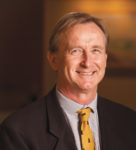Q&A with Drs. Valerie Norton & Jonathan Worsey
In March 2018, Scripps Health appointed five experienced physicians to newly created physician operations executive positions at each of its hospital campuses in California’s San Diego County. The move was part of an ongoing redesign of the healthcare delivery model by the San Diego-based nonprofit system and created the model of a physician operations executive paired with an administrator chief operations executive at each hospital. Together they share joint responsibility in managing day-to-day hospital activities, as well as supporting systemwide initiatives under two regional chief executives, one responsible for northern San Diego County and the other for the southern portion of the county.
Scripps’ decision to place actively practicing physicians in administrative roles is consistent with a larger movement taking place across the healthcare industry. As hospitals and physicians scramble for their share of shrinking reimbursements, it has become increasingly crucial for them to better understand one another’s perspectives and align their goals to achieve improved patient outcomes at lower costs.
Now seated for a full year as Scripps’ physician operations executives, Valerie Norton, M.D., and Jonathan Worsey, M.D., spoke with HealthTrust about their roles.
What were Scripps’ goals in appointing physician operations executives?
NORTON: Recent literature showed that institutions and systems that had incorporated physicians as administrators and leaders were doing better overall than those that had not. This improvement was seen not only in terms of patient and quality outcomes, but also in economic results.
Physicians drive much of healthcare spending. Until you make physicians your partner in the business of running hospitals and clinics, you will never fully manage those costs in a rational, evidence-based manner that speaks to the clinical outcomes of the patient as well as the business strategies of the organization. Physicians need a peek behind the curtain at what’s going on with financials, because most of them have absolutely no idea how to support any of those strategies. They want their institutions to be successful, but they may not understand the business imperatives or the cost structures, and they aren’t aware of how things are spiraling out of control in some sectors, such as implants and pharmaceuticals. Once you show physicians ways to improve cost-effectiveness, they’re almost universally happy to help.
What are some of your new responsibilities?
WORSEY: Our main responsibility is to communicate the goals, concerns and perspective of senior hospital administration to the physicians and then relay the concerns of our medical staff back to the administration. Only when everyone realizes there is already significant alignment of purpose will we able to cooperate and collaborate to reconcile any differences that exist. We also need to ensure that our physician colleagues see us primarily as practicing physicians who also a have senior administrative position rather than vice versa. No matter how long and glittering a career a physician may have had, once they become a full-time administrator with no clinical work, they are viewed very differently.
Another important responsibility is that we, as practicing physicians, are expected to have conversations regarding cost and utilization with our physician colleagues, since they are doing the actual work and must have a voice in the decision-making. Though these discussions may not be in our respective fields, we still have a better understanding of day-to-day patient care than our full-time administrators. We speak a language our colleagues can understand and can better appreciate the pressures and constraints our fellow physicians are experiencing.
NORTON: We are here to be agents of change and influence by getting people to concentrate on the triple aim: improving the patient experience, improving population health and reducing the per-capita cost of healthcare. The crowning achievement would be best-in-the-world outcomes, with a fantastic care experience, at the least possible cost. That’s what provides the best value to the patient.
It’s important to forge a partnership between clinicians, administrators, managers and pharmacists to determine what your goal should be with respect to that triple aim. You can’t have everything. Sometimes you can only have better quality for a higher price. At that point, it’s about achieving the smallest price increase necessary to get that better quality. Sometimes you can cut costs, but only at the risk of a poor patient experience.
There are moments where you get all three and it’s a win-win-win. It’s up to us to find and promote the situations that are triple wins. I actually keep a list of those in my office. For situations that are not triple wins, where there are tradeoffs, it’s our job to negotiate the best possible compromise.
What are some of those “triples”?
NORTON: One example is enhanced recovery after surgery, or ERAS. ERAS has been practiced in Europe for 20 years with amazing results. But in the United States, we’ve been slow on the uptake because incentives have not been properly aligned in our healthcare system. ERAS is the bundle of care components that optimizes the surgical experience: It’s all about educating patients, setting expectations and then enhancing every detail of what happens to them weeks before surgery through their postop recovery period.
It’s not about surgical technique; it’s the small stuff, such as educating patients to use as few opioids as possible while they’re recovering and trying to tolerate some pain so they can avoid all the complications of opioids. Those complications include increased constipation, wooziness, vomiting and feeling unsteady on their feet—the kinds of issues that keep them in the hospital longer and prevent them from recovering faster. There is a lot of literature showing that minimizing the use of opioids improves recovery. That’s a big part of ERAS, and it includes the use of more non-opioid alternatives and educating patients about what to expect.
Another part of that triple win is not making patients fast before surgery. In the past, if you had an operation, you couldn’t eat or drink anything after midnight the night before. It turns out that’s not based on science. It’s just wrong. Now we allow patients to drink clear liquids up until two hours before surgery—ideally, a beverage such as Gatorade that contains carbohydrates. When they arrive for surgery well-hydrated and in a non-fasting state, they do better. Surgery is less stressful on their body, they recover faster, and they have fewer complications and wound infections.
These strategies not only result in cost savings. Patients are happier because they have an improved understanding of the whole surgical process and feel like they’re a participant in it. It’s a better patient experience all around, and it ends up saving them money because they have a shorter stay in the hospital and fewer return visits and readmissions. It’s a totally out-of-the-ballpark, triple-aim win.
We’re working hard on trying to spread this philosophy throughout our system. It can sometimes be an uphill battle because we’re going against tradition and dogma and trying to change decades of received wisdom.
What additional value do physician administrators bring to your hospitals?
WORSEY: When it comes to talking to physicians about the way they practice medicine and asking them to consider change, I think it’s far easier for us to have those conversations. The standard response of, “You administrators just don’t understand what I do,” does not really hold true in this new arrangement.
That proved to be the case when we had an issue of overutilization of antibiotic bone cement in joint replacement as compared to accepted benchmarks. We gathered our orthopedic surgeons at the system care line and showed them data that we use a lot of antibiotic bone cement with significant added expense but with no demonstrable improvement in patient outcomes. After several meetings with our surgeons, we were able to discuss the literature and our own data from the perspective of fellow clinicians and came to an agreement on selective use following published guidelines.
Our goal is to persuade our physicians to give the same attention to cost and utilization as they already do to quality and patient satisfaction—so much so that it becomes an automatic consideration.
NORTON: Another area where we have been successful is in developing, mentoring and coaching a succession of young physician leaders. For instance, we needed a person to manage all the electronic medical record challenges that physicians are voicing and be the liaison to the IT department. I identified a brilliant physician who also has an informatics degree, and asked if Scripps Health could provide a small stipend for him to be the conduit between all the doctors and IT. Scripps agreed, and he is knocking it out of the park. Everybody loves him. He sends out tip sheets, and anytime a physician has a problem with the computer system, they contact him. It’s been a tremendous win.
Can you offer any advice for systems wanting to incorporate physician administrators?
WORSEY: My advice for other hospital systems is to both choose your physician carefully and then design the position to be meaningful with well-defined authority, responsibilities and a real role in major decision-making.
The ideal physician for such a role is an actively practicing and well-respected clinician, with medical staff leadership experience and some existing administrative experience in areas such as cost or quality. They have to have the vision to understand and reconcile the viewpoints of the different constituents that make up a hospital and health system.
For these positions to be meaningful, they cannot simply be honorary titles. Scripps has committed to giving us access to the top-level operational and financial meetings and reports, and we have a voice in decision-making. Both of these are crucial. Finally, to be effective, the position has to be seen as one that advocates for the patients and physicians just as much as it does for administration and the bottom line.
 Valerie Norton, M.D., has been chief operations executive physician at Scripps Health since March 2018. A specialist in emergency medicine, she has served as president of her medical group, Pacific Emergency Providers, since 2005.
Valerie Norton, M.D., has been chief operations executive physician at Scripps Health since March 2018. A specialist in emergency medicine, she has served as president of her medical group, Pacific Emergency Providers, since 2005.Norton received an undergraduate degree from Yale University and a medical degree from the University of California at San Diego in 1991. She completed a residency in emergency medicine at UCLA in 1995. Norton was board-certified in emergency medicine in 1996. She has chaired multiple committees at Scripps, including Pharmacy & Therapeutics and Opioid Stewardship.
 Jonathan Worsey, M.D., has been chief operations executive physician at Scripps Health since March 2018. He started his private practice in colorectal surgery at Scripps Memorial Hospital in La Jolla, California, in 1999.
Jonathan Worsey, M.D., has been chief operations executive physician at Scripps Health since March 2018. He started his private practice in colorectal surgery at Scripps Memorial Hospital in La Jolla, California, in 1999.Worsey received an undergraduate degree from the University of Cambridge and a medical degree from St. Thomas’ Hospital, London, England, in 1985. He completed an internship in surgery at St. Thomas Hospital and a surgery residency at the University of Pittsburgh. He received additional training at the Cleveland Clinic Foundation. Worsey was board-certified in surgery in 1998 and in colon and rectal surgery in 1999.
Worsey is the author of 58 papers, book chapters and presentations. He is currently a reviewer of papers submitted to Diseases of Colon and Rectal Surgery, the journal of the American Society of Colon and Rectal Surgeons. He also serves on the Scripps’ ACO board and as system medical director for value analysis.






